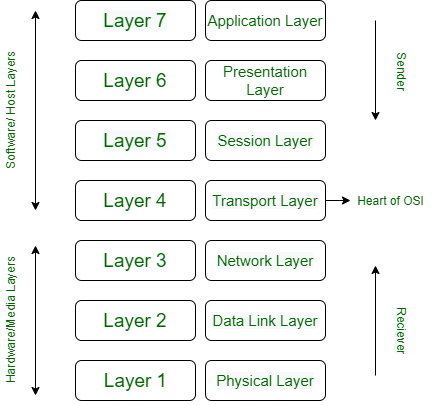OSI model is a Modular Standard Communication Architecture which has layer approach for communication, where one layer speaks to another layer.
Each layer adds a header when an message is sent over the network for encapsulation, then each layer goes through process of peeling the header in order to get the message to the other side.
OSI Model Layer Approach:
Application Layer
Presentation Layer
Session Layer
Transport Layer
Network Layer
Data Link Layer
Physical Layer
(aka: All People Seems To Need Data Processing… Easy way to remember)
Application Layer:
In this layer application layer and user communicate directly based on software application. It identifies communication partner, and determine the resource availability in terms of HTTP, FTP, SMTP.
Presentation Layer:
It translate the application layer data to another frame. This layer is responsible to format data in terms of encrypting/decryption and then sent over in XML or JPEG.
Session Layer:
This layer is responsible for session management for encoding and decoding of data to send over. Where it create, specifies, establish, manages, control and terminate the connections. It allow IP between the applications using SSL/TLS or SSH or NetBios.
Transport Layer:
This layer is responsible for reliable end to end data services using ports TCP or UDP. As a message is sent across the network port for communication whether it is connection oriented or connection less.
Network Layer:
It will have packets, where it takes the data and route it back and forth across different network and do re-packaging to cover the gap between the layers. When we do not know about what type of physical connection is being used. It does logical addressing to ensure data reachability.
Data Link Layer:
It sends the data across the network in frames through physical medium. It does physical addressing or MAC Addressing.
Physical Layer
It handles all the physical definition of a data communication using coax, fiber, 4-pair wire where data are sent in raw bits, 0’s and 1’s.It has NIC and ports, HUBs works in this layer. It also handle error correction and detection on the physical medium.
Ground Work
Suppose we issues a web request, which gets originated at Application Layer for data transmission in HTTP or FTP or SMTP, then at Presentation Layer for data format in JPEG or XML then in Session Layer for encoding or decoding, then in Transport Layer we need to add any TLS communication then we add specific port of source and destination with respect to the mode of communication then in Network Layer we add IP address of the destination then we add ethernet header on top of it and then we sent it off. Each layer adds a header when an message is sent, goes through each layer over the network for encapsulation. When it reaches the other end it will actually repeats this process in reverse order, where each layer goes through the process of peeling the header in order to get the message to the other side.


Leave a Reply